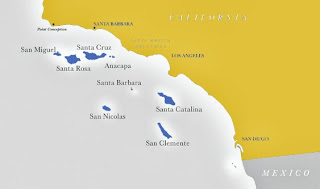Did you know that elephants are the best swimmers among land animals? It is interesting that Mammoths became "pygmy" by swimming West. It reminds me of a story from my family.
My grandmother was born in North Dakota. She was a strong Norwegian woman. She once asked my dad why he decided to move to Hawaii. What was wrong with their idyllic life in sunny California, she wondered?
"It's simple," he responded. "I'm doing the same as you did -- I'm just heading further West."
Ah... the beacon call to head West, somewhere over the horizon. I have felt that tug, and bought a sailboat. It is the search for opportunity, for novelty, for 'greener fields'.
40,000 years ago, the Mammoths also felt that urge:
 "Leaving the heavily grazed mainland behind, the mammoths swam towards the scents of abundant vegetation from the huge, mountainous island of Santarosae" (National Park Service)
"Leaving the heavily grazed mainland behind, the mammoths swam towards the scents of abundant vegetation from the huge, mountainous island of Santarosae" (National Park Service)
Back in those icy times (with lower sea levels), the four northern Channel Islands were united into one large island, "Santarosae". The 14ft tall Columbian Mammoths smelled the fresh grass, and took a risk. They swam 4-6miles to the unexploited pastures. Was it their wooley version of Manifest Destiny? Or just a response to necessity, adventure, and spontaneity?
As the Earth warmed and sea level rose, the islands split up and became smaller. Less food became available. So the smaller mammoths began to live longer. They became smaller and smaller, until they had shrunk from 14ft to just 7ft tall. Over the course of time, they evolved into... Pygmy Mammoths, a species only found in the California Channel Islands.
Different Mammoth and Elephant sizes
Why is the Pygmy Mammoth the mascot for this sailing trip, you wonder? Besides being unique to the Channel Islands, they are an icon of Change -- and this is what we're trying to understand. What sudden changes have the islands dealt with, and where is restoration leading us? Who better to guide us than an invasive animal (they swam to the island) that turned endemic (found nowhere else)? At least, their paradoxical nature will help us ask fresh questions.







